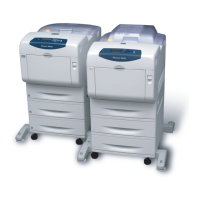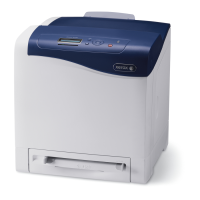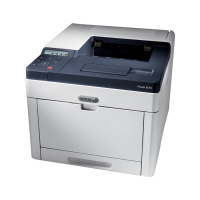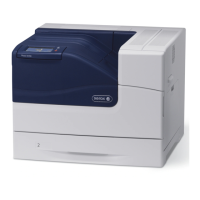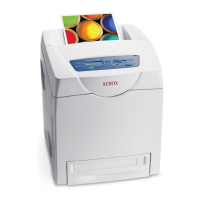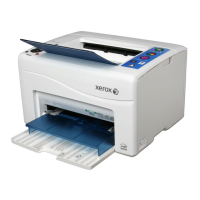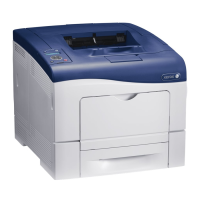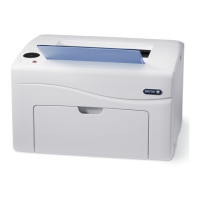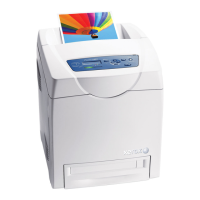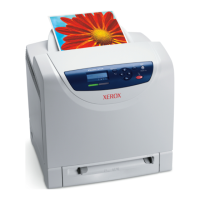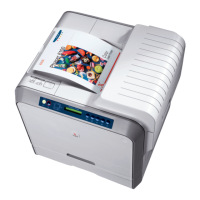Theory of Operation 2-3
Summary of the Printing Process
The printing process is summarized in the following steps. While reading the
summary, refer to the figures on pages 2-2, 2-5, and 2-6. These diagrams show
process flow and indicate the relative position of the components involved. The
diagrams also include reference numbers that correspond to each numbered step.
1. Charging: The charge roller (RTC) is negatively charged by the High Voltage
Power Supply (HVPS) and is kept in contact with the drum surface to provide a
uniform negative charge on the drum as it rotates at a constant speed. This occurs
simultaneously for YMCK. The refresher is a conductive brush that is also
negatively charged by the HVPS to pick off any toner particles left on the drum
after image transfer to the IDT.
2. Exposure: The Laser Unit uses a system of mirrors and lenses to scan the drum
surface in response to image data from the Image Processor. Where the laser
exposes (writes) the drum surface it reduces the negative charge to form an
invisible latent image. This process is preformed simultaneously for YMCK.
3. Development: Toner is electrostatically attached to the invisible latent image
on the drum surface to form the visible image on the drum. Toner is fed into the
developer using the agitator in the Toner Cartridge and auger system in the
TCRU. The toner and the carrier in the developer form a homogeneous layer on
the magnet roller in the Developer Assembly. The magnet roller turns against the
surface of the drum and is kept at a constant negative potential. At areas on the
drum surface where the negative charge has not been reduced by the impact of
laser light, potential between the drum and the toner particles is lower than that
between the magnet roller and the toner particles. At areas where the drum
charge has been reduced, the potential between the particles and drum is higher
than between the magnet roller and toner particles are attracted to the drum. A
thin semiconducting sleeve on the magnet roller is vibrated by an AC voltage to
encourage migration of the toner particles to the drum. When the toner particles
attach to the drum, the negative charge of the particles reduces drum potential at
that point, thus reducing the attraction of additional toner particles. This process
occurs simultaneously for YMCK.
4. Primary Transfer (drum --> IDT1): The toner image formed on the individual
drum surface is transferred onto the surface of the IDT1 (Intermediate Drum
Transfer 1: intermediate transfer roller 1). There are two IDT1’s: one for yellow
and magenta and one for cyan and black. IDT1 is conductive and receives a high
positive charge from the HVPS. The negatively charged toner image on the drum
surface is attracted by the high positive potential and transfers to IDT1. During
this transfer, the remaining negative charge on the drum is neutralized by the high
positive charge on IDT1.
5. Secondary Transfer (IDT1 --> IDT2): The toner images formed on both
IDT1 surfaces are then transferred onto the surface of IDT 2 to create a complete,
4-color toner image. IDT2 is biased at a higher positive potential than IDT1 thus
attracting the toner image and transferring it from IDT1 to IDT2.
6. Cleaning: The IDT1 cleaner consists of a conductive roller brush rotating in
contact with IDT1 after the point where the toner is transferred to IDT2. The
cleaner receives a high positive voltage from the HVPS allowing it to electrically
attract any toner particles remaining on IDT1. Toner remaining on both IDT1’s
after the image transfer to IDT2 is temporarily stored in the IDT1 cleaners.
